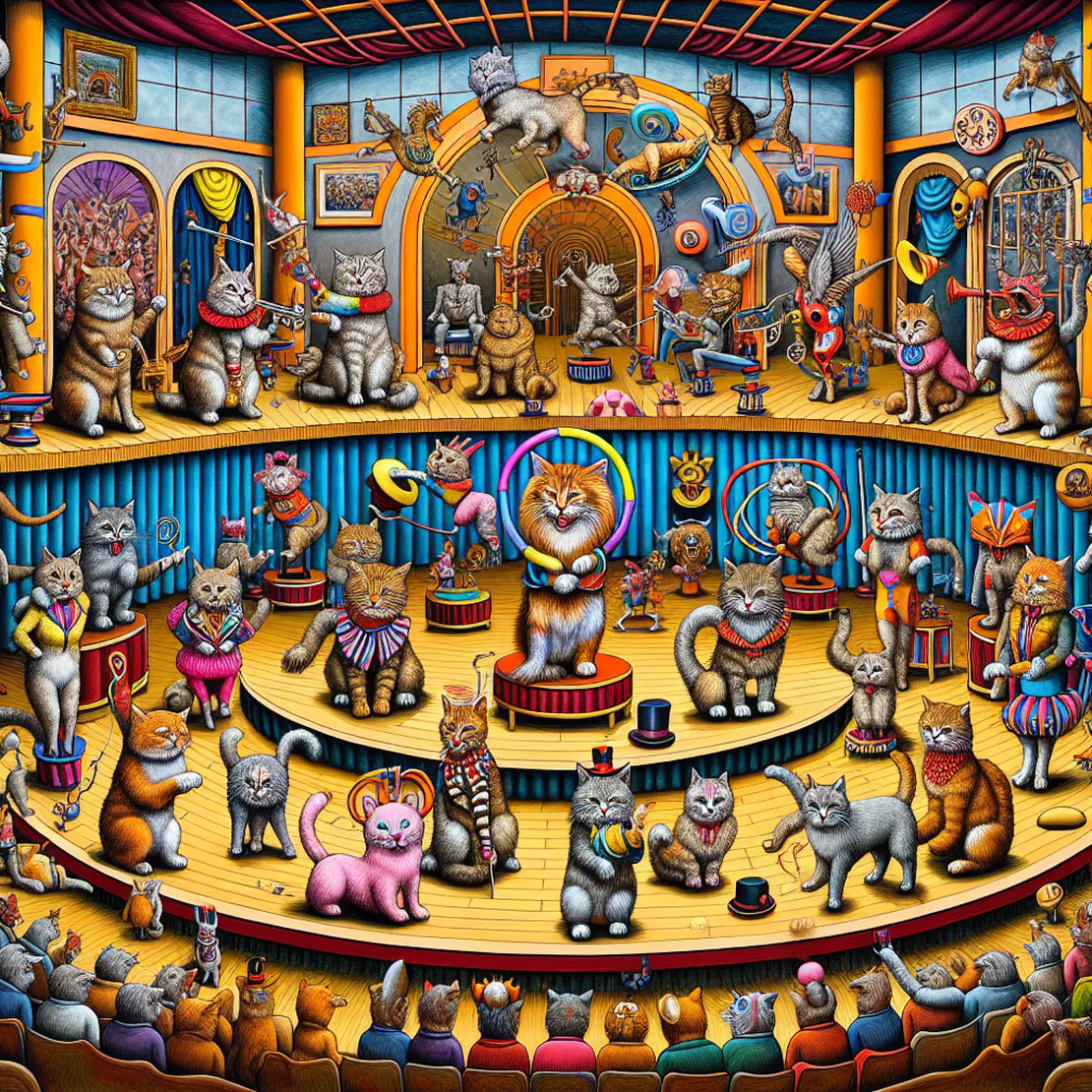
E539 Samantha Martin and the Amazing Acro-Cats
- This Past Weekend
- Cats
- October 17, 2024
Table of Contents
At a Glance
-
Cats’ Independent Nature - “Yeah, they decide what they wanna do, when they wanna do it, if they wanna do it.” This highlights the unpredictable and autonomous nature of cats, which adds a humorous and challenging element to training them.
-
Improvisational Aspect - “It’s almost like improv. Oh, it is improv. It’s totally improv, yeah.” This emphasizes the spontaneous and unpredictable nature of working with cats, likening it to an improvisational performance.
-
Training for Emergencies - “All of my cats are whistle trained to go to a carrier, which is great for emergency situations.” This point is significant as it shows the practical training and preparedness involved in handling multiple animals safely.
-
Audience and Cat Interaction - “Wiki does not like people with big hair in the front row.” This adds a humorous aspect to the show, highlighting how specific and quirky the cats’ preferences can be.
-
Camping and Training - “Yeah, to adopt out or to be in the show. I wanna bomb proof them so that they’re comfortable in any atmosphere.” Important for showing the extensive and serious preparation the cats undergo to ensure they are adaptable and comfortable in various environments.
-
Use of Clicker Training - “I click and treat during that moment, and I turn that bad experience into a good experience.” This demonstrates a positive reinforcement technique used to help cats associate potentially scary situations with positive outcomes.
-
Performance Challenges - “And he’s like, okay, all right, fine. Just stop. I’ll do it.” This humorous exchange during a show illustrates the dynamic and often comedic interactions between the trainer and the cats.
-
Audience Impact - “I haven’t smiled, I was going through cancer and I haven’t smiled in three years and this is the first time I’ve smiled.” Highlights the profound emotional impact the cat show can have on audience members, underscoring its importance beyond entertainment.
-
Show Must Go On - “I am one of those, like literally, the show must go on.” Emphasizes the dedication and professionalism in performing despite personal challenges, such as illness or voice loss.
-
Epic Fail Turned Learning Experience - “The cat’s doing nothing, but isn’t that great?” Reflects on a past performance failure that turned into a learning and growth opportunity, showing resilience and adaptability in the face of challenges.
What to Do
-
‘Let them learn it themselves’ - Teaching themselves is considered the best way as it leads to self-discovery and a deeper understanding.
-
‘Be patient and wait’ - Sometimes, allowing learners to explore on their own time encourages them to engage more deeply and have that ’light bulb’ moment.
-
‘Respect their creativity and adaptability’ - Acknowledging and appreciating the learner’s own methods or tricks can enhance their learning experience and foster innovation.
-
‘Go with the flow on stage’ - In unpredictable situations, adapting to the circumstances rather than trying to control everything can lead to a smoother experience.
-
‘Use high rewards for motivation’ - Offering something valuable can encourage more effort and engagement from the learner.
-
‘Never force participation; make it enjoyable’ - Ensuring that the activity is fun and voluntary increases participation and interest.
-
‘Personalize the experience’ - Adding personal touches and considering individual preferences can make the experience more relatable and engaging for everyone involved.
-
‘Recognize the signs of discomfort and adjust accordingly’ - Being attentive to discomfort and making necessary changes ensures the well-being of the participants.
-
‘Encourage through positive reinforcement’ - Using applause and laughter as rewards can motivate participants to continue engaging and performing.
-
‘Consistency and persistence in training’ - Regular practice and consistent effort lead to better outcomes, even if initial attempts are challenging.
-
‘Be prepared to improvise’ - Flexibility in handling unexpected situations or responses can turn challenges into opportunities for creativity.
-
‘Build a strong, personal relationship’ - Developing a deep bond and understanding can enhance cooperation and performance in any interactive setting.
-
‘Acknowledge and adapt to individual learning paces’ - Recognizing and respecting each learner’s speed can make the learning process more effective and less stressful for everyone involved.
What to Get
-
Rollout floor - Brought in to make cats comfortable by having a familiar scent.
-
Carriers - Used to provide a safe space for cats, acting as a portable green room.
-
Clicker and Treats - Used for training cats, particularly to help them become acclimated to loud noises like fireworks.
-
Portable Incubators - Used for raising kittens, especially when traveling.
Summary
In this engaging podcast episode, the conversation revolves around the fascinating world of training cats for performances, specifically for a traveling cat circus known as the “acro cats.” The host interviews Samantha Martin, the trainer behind the acro cats, who shares insights into the complexities and joys of working with cats in a performance setting.
Samantha Martin explains that training cats is not just about teaching tricks; it involves creating a comfortable and stimulating environment where the cats can feel safe and motivated. She highlights that unlike traditional pet training, her approach is highly adaptive to each cat’s individual temperament and preferences. The cats are trained using positive reinforcement techniques, such as clickers and treats, which help turn potentially scary experiences like thunderstorms into positive ones.
Interestingly, the conversation touches on the challenges and unpredictable nature of live performances with cats. Cats, being naturally independent and sometimes aloof, can make live shows highly unpredictable, which requires a lot of improvisation and flexibility from the trainer. Despite the challenges, Martin emphasizes the importance of respecting each cat’s limits and ensuring their well-being, avoiding any tricks or situations that might cause discomfort or stress.
Another significant aspect of the discussion is the logistics and lifestyle of touring with cats. Martin shares anecdotes from the road, including emergency situations where the training proved invaluable in ensuring the cats’ safety. The logistical challenges of traveling with a large group of cats, dealing with vehicle breakdowns, and managing performances in different venues are also highlighted.
Overall, the podcast offers a fascinating glimpse into the unique challenges and rewards of working with cats in a performance setting, emphasizing the deep bond and mutual respect between the trainer and the animals. It also sheds light on the broader implications of such a lifestyle, both for the humans and the cats involved.

